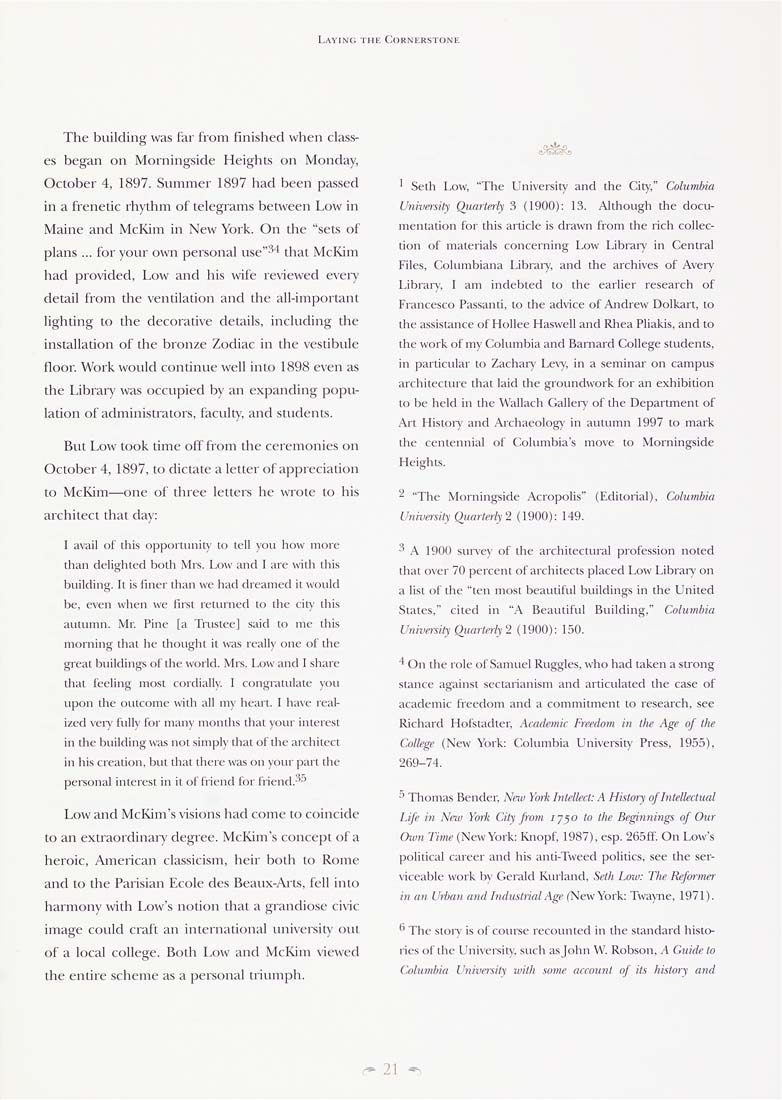Columbia Library columns (v.44(1995))
(New York : Friends of the Columbia Libraries. )
|
||
|
|
|
|
| v.44,no.2(1995:Autumn): Page 21 |

iL Cornerstone The building was far from finished when class¬ es began on Morningside Heights on Monday, October 4, 1897. Summer 1897 had been passed in a frenetic rhythm of telegrams between Low in Maine and McKim in New York. On the "sets of plans ... for your own personal use"'^* ii^^il McKim had provided. Low and his wife reviewed every detail from the ventilation and the all-important lighting to the decorative details, including the installation of the bronze Zodiac in the vestibule floor. Work would continue well into 1898 even as the Library was occupied by an expanding popu¬ lation of administrators, faculty, and students. But Low took time off from the ceremonies on October 4, 1897, to dictate a letter of appreciation to McKim—one of three letters he wrote to his architect that day: I avail of this opportunit)' to tell you how more than delighted both Mrs. Low and I are with this building. It is finer than we had dreamed it would be, even when we first returned to the cit\' this autumn. Mr. Pine [a Trustee] said to me this morning that he thought it was really one of die great buildings of the world. Mrs. Low and I share that feeling most cordially. I congratulate you upon the outcome with all my heart. I have real¬ ized very fully for many months that your interest in the building was not simply that of the architect in his creation, but that there was on your part the personal interest in it of friend for friend.-'' Low and McKim's visions had come to coincide to an extraordinary degree. McKim's concept of a heroic, American classicism, heir both to Rome and to the Parisian Ecole des Beaux-Arts, fell into harmony with Low's notion that a grandiose civic image could craft an international university out of a local college. Both Low and McKim ricwecl the entire scheme as a personal triumph. ^ Seth Low, "The University and the City," Columbia University Quarterly 3 (1900): 13. Although the docu¬ mentation for this article is drawn from the rich collec¬ tion of materials concerning Low Library in Central Files, Columbiana Library, and the archives of Avery Library, I am indebted to the earlier research of Francesco Passanli, lo the advice of Andrew Dolkart, to the assistance of Hollee Haswell and Rhea Pliakis, and to the work of my Columbia and Barnard College students, in particular to Zachary Levy, in a seminar on campus architecture that laid the groundwork for an exhibition to be held in the Wallach Gallery of the Department of Art Histon' and Archaeolog;' in autumn 1997 to mark the centennial of Columbia's move to Morningside Heights. - "The Morningside Acropolis" (Editorial), Columbia University Quarlerly2 (1900): 149. ^ A 1900 survey of the architectural profession noted that over 70 percent of architects placed Low Library on a list of the "ten most beautiful buildings in the United States," cited in "A Beautiful Building," Columbia University Quarterly 2 (1900): 150. * On die role of Samuel Ruggles, who had taken a strong stance against sectarianism and articulated the case of academic freedom and a commitment to research, see Richard Hofstadter, Academic Freedom in the Age of the College (New York: tiolumbia University Press, 1955), 269-74. ■' Thomas Bender, New Ymk Inlelkcl: A Histoiy of Intellectual Life in New York City from ly^o to the Beginnings of Our Oion Time (NewYork: Knopf, 1987), esp. 265ff. On Low's political career and his anti-Tweed politics, see the ser¬ viceable work by Gerald Kurland, Seth Low: The Reformer in an I'rhan and Industrial Age (^e-wYoT\:Tvi3.yne, 1971). '' The sU)i7 is of course recounted in the standard histo¬ ries of the University, such as John W. Robson, A Guide to Columbia University with some account of its history and .» 21 -^ |
| v.44,no.2(1995:Autumn): Page 21 |







